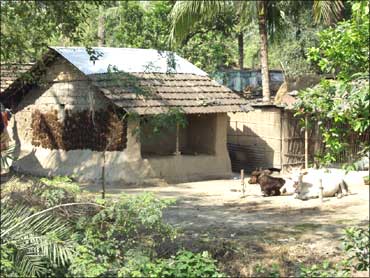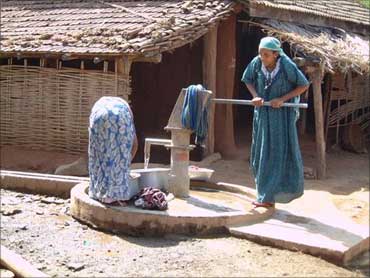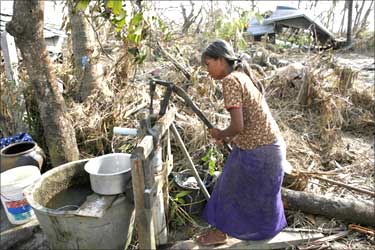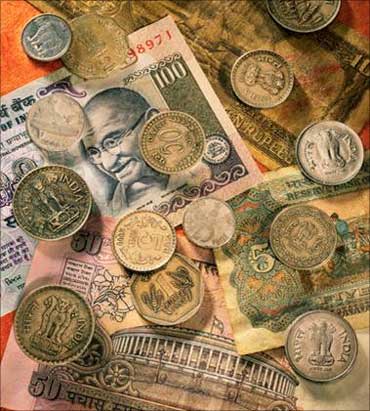
Join hands to clean water, ensure regular testing at little cost.
Banashree Bera and Alaka Jana are no ordinary women. Together, the two housewives from Chakrimulia village in West Bengal's Purba Medinipur district can dismantle and reassemble a tubewell in minutes.
It is a skill they have been perfecting for almost two decades on their primary drinking water source - a low-cost Tara hand pump that serves 57 families in the hamlet.
In the early 90s, Bera and Jana were trained to become 'caretakers' of the tubewell as part of an intensive sanitation programme undertaken by the Ramakrishna Mission.
With backing from the United Nations Children's Fund, the Mission attempted to establish a supply of potable drinking water across the then undivided Medinipur district, on a demand-driven model.
...

Upscaling issues
The model ran into trouble on the issues of scale and financial viability, which has held up its wider application, even within the state, as a 'user pays' model for availability of clean drinking water.
It is, however, a model which has been reworked on and is showing hopeful results on the ground in the 30-odd villages where it has been tried and the government agencies involved say they would like to replicate this.
It is not just repair and maintenance, but also provision of treated and clean drinking water round the year. The drinking water department of the Union rural development ministry has set aside 10 per cent of its Rs 9,000-crore (Rs 90 billion) budget to incentivise villages that can set up their own water management committees.
The idea is to make villages independent in terms of availability of clean drinking water.
The experiments in Medinipur offer some hope in that direction. Groundwater contamination has been a major cause for concern in Bengal, with the presence of unsafe levels of arsenic, fluoride and iron across water sources. Arsenic, for instance, affects 79 blocks of the state.
...

Today, Chakrimulia's water protection committees and caretakers, like Bera, are part of an effort which could create a scalable blueprint going beyond just supplying water.
"We realised it wasn't enough to provide water to the villages. It was important that the purity of this water be tested and, if required, treated. But, our biggest challenge was to create a sustainable model that could run independently. For this, we needed a system and funds," explains Nirmal Kumar Pattanayak of the Ramakrishna Mission Loksiksha Parishad, which has been administering the scheme across 28 village panchayats in East and West Medinipur.
So, the Mission decided to revamp its earlier administrative model, based on the local water protection committees, by adding two more tiers each at the village panchayat and block levels.
Through a series of democratic formations, the panchayat-level organisation will have representatives of all water sources falling under its ambit, with the panchayat head as the ex-officio chairman of the body.
...

Funding also required a structured solution, as water quality testing isn't inexpensive. A new laboratory, without accounting for the spend on land and building, costs Rs 15-20 lakh (Rs 1.5-2 million), with monthly recurring expenditure of almost Rs 30,000.
With an additional outgo for collection of samples and repair and maintenance of water sources, the bill for servicing 28 panchayats through 17 laboratories couldn't be met by the Mission alone.
"Financial sustainability was the primary aim. We had to find a model where the local population will be able to function independently in the long term without external monetary assistance. But, the villagers could not be inordinately burdened either," said Pattanayak.
New model
Consequently, a scheme was devised where each household using a certain water source will pay Re 1 a month for water quality monitoring. That would be enough to sustain the programme after just five years of financial assistance, claimed Pattanayak.
The maths behind the scheme is straightforward. The yearly cost of water quality testing per source, including maintenance and bacteriological treatment, is about Rs 600. With an average of 50 families per source paying Re 1 every month, the yearly collection will be Rs 600.
...

Over a five-year period, the collection will accumulate Rs 3,000, which if invested over the period at an eight per cent interest rate, will earn an additional Rs 240 every year.
The interest and collections taken together will mean Rs 840 a year for a water source - more money than it typically needs to sustain a water quality testing mechanism.
Sustainability apart, the Mission's project in Medinipur is part of a larger programme that the West Bengal government's public health engineering department is trying to push to upgrade its water quality testing infrastructure.
"There was a realisation that we did not have enough testing facilities, and the government couldn't set up all the laboratories by itself. In 2005, we brought in 20 non-government organisations to partner with us on the arsenic problem. Since then, the number of labs has gone up and the model has been scaled up to test both bacteriological and chemical contamination," a PHE department official said.
There are 116 water quality testing laboratories in West Bengal, of which 36 are under the PHE Department and 80 are administered by non-government organisations.
The aim for those pushing it is to create a sustainable, financially-independent system run by the people for themselves.
...

At villages like Chakrimulia, that requirement is being transformed into tangible results on the ground. This January, all 57 families, who use the handpump maintained by Bera and Jana, paid their yearly contribution of Rs 12 at one go.
The success of the entire pilot scheme will depend on other villages and hamlets playing their part and paying their share.
Nonetheless, elders like Aurobindo Bhim, who are part of a panchayat-level water protection committee, are content.
"When I was a child, we had to walk for an hour to reach a tubewell two km away so that we had enough drinking water for the family. In spite of that, the high iron content in the water meant many fell ill often. Today, that has changed," he said.
Next to him, women of the village walked by with their afternoon supply of safe drinking water from a handpump. A quiet revolution, where the population is paying for purity. It needs to be taken forward.